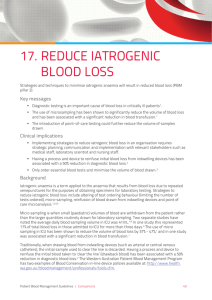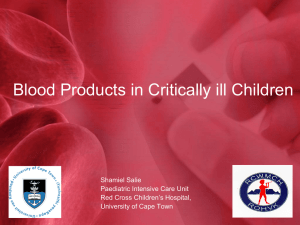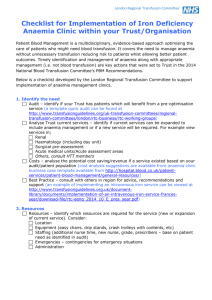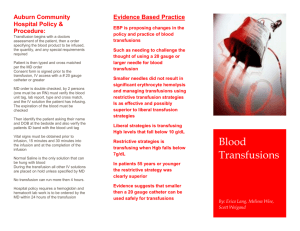WHITE PAPER Blood conservation with a patient dedicated arterial
advertisement
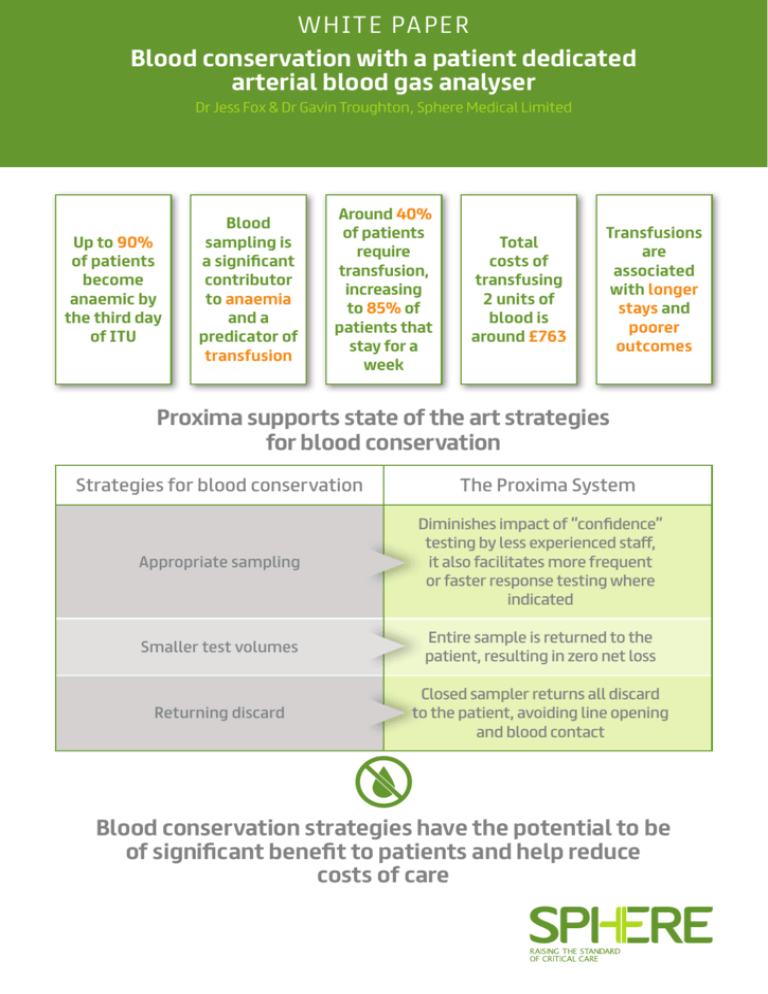
W H I TE PA P E R Blood conservation with a patient dedicated arterial blood gas analyser Dr Jess Fox & Dr Gavin Troughton, Sphere Medical Limited Up to 90% of patients become anaemic by the third day of ITU Blood sampling is a significant contributor to anaemia and a predicator of transfusion Around 40% of patients require transfusion, increasing to 85% of patients that stay for a week Total costs of transfusing 2 units of blood is around £763 Transfusions are associated with longer stays and poorer outcomes Proxima supports state of the art strategies for blood conservation Strategies for blood conservation The Proxima System Appropriate sampling Diminishes impact of “confidence” testing by less experienced staff, it also facilitates more frequent or faster response testing where indicated Smaller test volumes Entire sample is returned to the patient, resulting in zero net loss Returning discard Closed sampler returns all discard to the patient, avoiding line opening and blood contact Blood conservation strategies have the potential to be of significant benefit to patients and help reduce costs of care Blood conservation with a patient dedicated arterial blood gas analyser Dr Jess Fox & Dr Gavin Troughton, Sphere Medical Limited Introduction Anaemia is a frequent complication of critical care, with up to 90% of ICU (Intensive Care Unit) patients being anaemic by their third day in the ICU1. Anaemia is associated with poor patient outcomes, especially amongst those patients with cardiovascular disease2 3 4 5 . The treatments of choice for anaemia are the minimisation of blood loss and the transfusion of red blood cells when necessary. This paper explores the issues in critical care around anaemia, transfusions and blood conservation. With diagnostic testing being a significant factor in cumulative blood loss and the risk of anaemia, the use of a patient dedicated arterial blood gas analyser to minimise blood loss is described. Anaemia in the intensive care unit Causes The reasons for anaemia in critically ill patients are multifactorial and include acute blood loss (e.g. from trauma, surgery or internal bleeding), iatrogenic blood loss associated with diagnostic sampling and blunted red blood cell production6. Of these, the blood loss associated with diagnostic testing is the factor that is most easily in the control of the intensivist. Laboratory results are an important tool to achieve diagnosis and guide medical care, and a certain amount of blood is required to obtain this information. The gold standard for monitoring oxygenation, acid-base status and ventilation is an arterial blood gas measurement – and consequently is one of the most frequently ordered tests in the ICU7. Patients with indwelling central venous or arterial catheters have more frequent blood draws as blood sampling is easier7, and relatively large volumes are drawn in comparison to that needed for the measurement itself. When sampling from an arterial line it is important to remove an adequate discard volume to ensure that a representative blood sample is obtained. If an insufficient discard volume is removed, the sample will be contaminated with saline flush solution resulting in an increased cNa+ and cCl- and decreased cK+8. Consequently, removal of at least three times the dead space volume is recommended9 and the average discard volume drawn is 3.2ml10. Iatrogenic anaemia (also known as hospital-acquired anaemia) results from blood loss that occurs from collecting samples for laboratory testing. Blood samples may be drawn up to 24 times in a day within the ICU 6 11 12. Therefore a series of small iatrogenic blood losses can add up, resulting in patients becoming anaemic13. Table 1 shows reported average phlebotomy-induced blood loss (ml/day) for various ICUs. Reporting country Setting Average phlebotomyinduced blood loss (ml/day) USA Cardiothoracic ICU 377 USA General surgical ICU 240 USA Medical surgical ICU 41.5 UK First day in ICU 85.3 UK Following days 66.1 Europe Medical ICUs 41.1 Table 1: Average phlebotomy-induced blood lost in critically ill patients11 Effects of anaemia Oxygen delivery is determined by arterial blood oxygen content and cardiac output. Healthy individuals increase cardiac output in response to anaemia but many critically ill patients have limited capacity to generate the cardiac output required for adequate tissue oxygenation14. Due to the loss in oxygen carrying capacity, the consequences of anaemia in critically ill patients include reduced tissue oxygenation and eventually ischaemia of end organs. Correlating anaemia to outcome can be complex, as the anaemia itself can be caused by underlying co-morbidities. Studies on postoperative outcomes for anaemic patients who refused transfusion on religious grounds suggested that mortality was inversely related to postoperative haemoglobin level in comparison to a control group15. Other data have linked the increased risk of mortality with patients with cardiovascular disease15. Blood transfusions within the ICU Frequency of transfusions Due to the prevalence of anaemia in intensive care, a large number of patients receive blood transfusions17 in the form of packed red blood cell (PRBC) transfusions1. In two large multicentre cohort studies in the United States and Western Europe, 37% and 45% of intensive care patients received PRBC transfusions respectively1 18. Longer stays result in a higher rate of transfusion with a reported 85% of patients residing in the ICU for one week or more requiring blood transfusions10. Consequences • Follow up checks Blood transfusions are expensive, can have deleterious effects on patient outcome and can be in short supply17. • Overhead Although the risks are very low19, PRBC transfusions include the following adverse effects, all of which lead to significant morbidity and mortality20 21: • Allergenic/anaphylactic and haemolytic transfusion reactions • Transfusion-related acute lung injury (TRALI) • Transfusion-associated circulatory overload (TACO) • Acute respiratory distress syndrome (ARDS) • Ventilator-associated pneumonia • Nosocomial infection risk (viral, bacterial, parasitic or prion transmission) – The absolute risk for nosocomial infection was 12% among conservatively-transfused patients and 17% among liberally-transfused patients, i.e. for every 38 patients treated under a liberal transfusion strategy, another hospital-acquired infection resulted 22 There is also a growing appreciation of the less recognised risks of transfusion relating to PRBC storage effects and to the immunomodulatory effect of PRBC transfusion23. Critically ill patients are likely to be more at risk of immunosuppressive and microcirculatory complications of blood cell transfusions than the general population24. The transfusion decision The traditional trigger for red blood cell transfusion is a haemoglobin reading of 10g/dL or less. With the growing understanding of the side effects, there have been a number of studies carried out to compare restrictive and liberal transfusion regimes. These have demonstrated that a restrictive regime can be associated with lower rates of organ failure and mortality3. A recent guideline document based on a review of the available evidence concluded that a threshold of 7g/dL should be used for critical care patients unless there were specific comorbidities or acute illness-related factors, such as sepsis, neurotrauma or ischaemic heart disease16. Costs associated with transfusions Estimates of the cost of transfusions vary widely, depending on the scope of what is used in the calculation. Some or all of the following can be included: • Acquisition, screening and storage • Staff and hospital costs • Management of inventory • Pre-transfusion testing • Management of side effects A recent meta-analysis of six studies concluded that a two unit transfusion of blood in Europe cost an average of £76325. Taking into account the management of complications, the Mayo Clinic have estimated the true total cost of transfusion of red blood cells to be £775 for a single unit 26. Transfusions are therefore a significant cost in critical care, and avoidance of transfusion is a worthwhile economic, as well as clinical, goal. Blood conservation strategies The main methods for reducing the contribution of blood tests to the incidence of iatrogenic anaemia have been identified as 27: • Reduction of unnecessary testing • Drawing smaller samples • Re-infusion of the discard volume Appropriate testing While there have been repeated calls in the literature to reduce the frequency of blood measurement, studies to evaluate the effect of education on the appropriate use of phlebotomy have not shown a significant change in practice13. Evidence shows that avoidance of excessive testing is hard to implement24 and ICUs presently continue to take what is seen as a high number of blood draws. Arguments for the correct frequency of testing can be retrospective in nature, determining from the test result that the patient’s therapy was in control, therefore a test was not needed. This ignores whether it is readily apparent before the test that the patient was in an acceptable state, particularly given the range of experience in critical care staff. A further issue that is rarely discussed in the literature is whether more frequent testing in some patients could be desirable in order to more rapidly detect deteriorating conditions and intervene. Introduction of continuous measurement modalities often identify that large excursions in condition occur much more frequently than is evident from intermittent measurement28. There are systemic factors of staff cover and blood gas analyser availability that make both rapid and frequent testing of the unstable patient difficult. This has, for example, led to difficulties in implementing protocols such as tight glycaemic control29. Drawing smaller samples If collection tubes are used for blood sampling, switching from adult- to paediatric-sized tubes may reduce the diagnostic blood loss by over 40% 30. For the majority of blood gas analysers, a typical sample volume of 150µl will provide results for blood gas, electrolytes, haemoglobin, haematocrit and blood sugar. However in a 2001 survey, O’Hare found that paediatric tubes were routinely used in only 14% of adult ICUs 10. Whilst the use of paediatric sampling tubes reduces the volume of blood drawn from a patient, it does not address blood loss associated with the discard volume. A limited survey of current practice in the UK (Table 2) indicates that there has not been a substantial change in practice with regards to either limiting discard volume or the use of smaller draw volumes. Centre Discard volume Sample volume 1 10 ml* 2 ml 2 3 ml 1 ml 3 3 ml 1 ml 4 5 ml 2 ml 5 5 ml 2 ml 6 5 ml 2 ml 7 5 ml 2 ml Average 5.1 ml 1.7 ml * Drawn from just under the pressure transducer, estimated to contain ~ 5 ml blood. Table 2: Discard and sample volumes drawn in seven UK adult critical care settings reservoir within the line’s circuit. This allows for return of the discard volume to the circulation whilst maintaining a closed system. A recent review article of the relatively limited clinical literature24 concludes that use of closed blood samplers: • Reduces the amount of blood drawn • Does not have a detrimental effect on the rate of catheter related infections • Has promising evidence for the reduction of anaemia and transfusions The strongest evidence for the latter was a 250 patient study that found the use of a blood conservation device was independently associated with lower RBC transfusions (control group 0.13 units vs. active group 0.068 units RBC/ patient/day)17. The study had broad inclusion criteria, and it is likely that patient groups requiring higher rates of testing and therefore more at risk of anaemia are likely to have benefitted more than this averaged figure. Patient dedicated analysers and blood conservation The Proxima System is a patient dedicated blood gas analyser (Figure 1). The Proxima Sensor is integrated into the patient’s arterial line operating as a closed system to minimise blood handling and infection risk. During the sample measurement procedure, the user draws blood into the Proxima Sensor using a closed sampler device. Once the sample has been analysed, all blood is returned to the patient. Results are displayed on the bedside monitor. Table 3 presents the design features of the Proxima System and how common effective blood conservation strategies are addressed within this new medical device. Re-infusion of the discard volume When sampling from an arterial or venous catheter, it is important to remove an adequate amount of discard volume to ensure that a representative blood sample is obtained. One of the simplest methods to address iatrogenic blood loss is to re-infuse the discard volume once the blood sample is drawn13. Re-infusion of the discard volume is not without risk e.g. potential to reinfuse clot(s)/contaminated discard, potential for error including the possibility of confusing the discard syringe with the blood sample31, infection and air embolism10. Closed sampler devices allow sampling of undiluted blood whilst safely storing the discard volume in a Figure 1: The Proxima System designed for on-demand bedside blood gas analysis Blood conservation strategy Appropriate sampling How a patient dedicated system helps • By substantially changing the constraints around blood loss, incremental cost and staff impact, a patient dedicated blood gas analyser redefines the boundaries of what is appropriate testing frequency. • As well as diminishing any impact of the more frequent “confidence” testing by less experienced staff, it also facilitates more frequent or faster response testing where indicated. Smaller test volumes • By integration of the blood gas analyser into the arterial pressure monitoring set, the analysed blood sample is retained within the set during the measurement process. • After analysis, the entire withdrawn sample is returned to the patient, resulting in zero net loss. Returning discard • The system incorporates the use of a closed sampler device within the design. • As well as allowing all discard to be returned safely to the patient, there is no need to open the line to withdraw a sample, thereby reducing the risks of introducing an infection or handling potentially infectious blood. Table 3: Design features of the Proxima System that address blood conservation strategies Conclusions •Medical personnel can cause substantial blood losses in their patients – phlebotomy is an extensively studied example. Diagnostic blood loss is a major determinant of anaemia in ICUs, accounting for substantial amounts of transfused blood. Within the ICU setting, the total amount of diagnostic blood loss is a significant predicator of allogeneic transfusion • Transfusions are associated with poorer outcomes and longer stays • Transfusions and delayed discharge both cost money • Blood conservation strategies have the potential to be of significant benefit to patients and will help reduce costs of care. Proxima embodies a device that supports state of the art strategies for blood conservation while allowing more frequent blood gas measurement if appropriate References 1 Corwin HL, et al., The CRIT Study: Anemia and blood transfusion in the critically ill – current practice in the United States. Crit. Care Med., 2004, 32: 39-52. 17 Mukhopadhyay A et al., The use of a blood conservation device to reduce red blood cell transfusion requirements: a before and after study, Critical Care, 2010, 14:R7. 2 Carson JL, Duff A, Poses RM, et al.: Effect of anaemia and cardiovascular disease on surgical mortality and morbidity. Lancet 1996, 348:1055–60. 18 Vincent JL., et al., Anemia and blood transfusion in critically ill patients , JAMA, 2002, 288: 1499-1507. 3 Hebert PC, Wells G, Tweeddale M, et al.: Does transfusion practice affect mortality in critically ill patients? Transfusion Requirements in Critical Care (TRICC) Investigators and the Canadian Critical Care Trials Group. Am J Respir Crit Care Med 1997, 155:1618–23. 4 Wu WC, Schifftner TL, Henderson WG, et al.: Preoperative hematocrit levels and postoperative outcomes in older patients undergoing noncardiac surgery. JAMA 2007, 297:2481–8. 5 Kulier A, Levin J, Moser R, et al.: Impact of preoperative anemia on outcome in patients undergoing coronary artery bypass graft surgery. Circulation 2007, 116:471–9. 6 Tinmouth AT., et al., Blood conservation strategies to reduce the need for red blood cell transfusion in critically ill patients. CMAJ, 2008, 178: 49-57. 7 Woodhouse S., Complications of critical Care: Lab testing and iatrogenic anemia, Med Lab Obs. 2001, 33(10):28-31. 8http://www.avoidpreanalyticalerrors.com/#en/handbook/ arterial+line/sample+contamination downloaded 10 June 2015. 9 Wennecke G, et al. Avoiding pre-analytical errors – in blood gas testing, 2008, ISBN87-88138-94-1. 19 Bolton-Maggs P, Cohen H: The 2011 Annual SHOT Report (2012); 2012. http://www.shotuk.org. 20 Kleinman S, Chan P, Robillard P: Risks associated with transfusion of cellular blood components in Canada. Transfus Med Rev 2003, 17:120162. 21 Shorr AF, Jackson WL, Kelly KM, Fu M, Kollef MH: Transfusion practice and blood stream infections in critically ill patients. Chest 2005, 127:1722-1728. 22 Jeffrey Rohde et al. Health Care–Associated Infection After Red Blood Cell Transfusion: A Systematic Review and Meta- Analysis. JAMA. 2014;311(13):1317-1326. 23 Marik PE, Corwin HL: Efficacy of red blood cell transfusion in the critically ill: a systematic review of the literature. Crit Care Med 2008, 36:2667–74. 24 Page C., et al., Blood conservation devices in critical care: a narrative review, Annals of Intensive Care, 2013, 3: 14-19. 25 Abraham I, Sun D. The cost of blood transfusion in Western Europe as estimated from six studies. Transfusion 2012;52:1983-1988. €877 converted at 2011 average rate of €1.15 to £1.00. 10 O’Hare D et al., Arterial blood sampling practices in intensive care units in England and wales. Anaesthesia 2001; 56:568-70. 26http://www.mayomedicallaboratories.com/articles/hottopics/ transcripts/2009/2009-8a-transfuse/8a-18.html downloaded 10 June 2015. $1241 converted at 2009 average rate of $1.60 to £1.00. 11 Fowler RA, Berenson M: Blood conservation in the intensive care unit. Crit Care Med 2003, 31:S715-S720. 27 Liron M., Letter to the Editor – Nosocomial anaemia, Eur Heart J. 2007 Oct;28(20):2551. 12 Shander A., Blood conservation strategies. Adv. Stud. Med., 2008;8(10):363-368. 28 Menzel M et al., Experiences with continuous intra-arterial blood gas monitoring. Minerva Anestesiol. 2001 Apr;67(4):325-31. 13 Seeber P, Shander A, Chapter 12, page 160, Basics of Blood Management, 1st Edition, 2007, Wiley-Blackwell, ISBN 978-1-40515131-3. 29 Sheehy A. et al. An Overview of Preoperative Glucose Evaluation, Management and Perioperative Impact Journal of Diabetes Science and Technology 2009, 3:1261-1269. 14 Rudis M et al., Managing Anemia in the Critically Ill Patient, Pharmacotherapy. 2004;24(2). 30 Smoller BR., et al., Reducing adult phlebotomy blood loss with the use of paediatric-sized blood collection tubes, Am. J. Clin. Pathol. 1989, 91: 701-703. 15 Carson JL, Spence RK, Poses RM, Bonavita G. Severity of anaemia and operative mortality and morbidity. Lancet 1988;1:727-9. 16 Retter A. et al.: Guidelines on the management of anaemia and red cell transfusion in adult critically ill patients, British Journal of Haematology 2013, 160: 445-464. 31http://pda.rnao.ca/content/blood-withdrawl-central-venous-accessdevices downloaded 14 June 2015.


